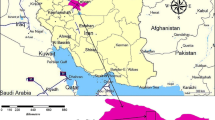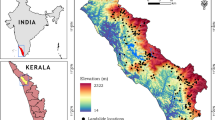Abstract
The twin Ahar-Varzeghan earthquakes (Mw = 6.4 and Mw 6.2, August 12, 2012) are among the most severe and destructive seismic events to have occurred in the northwest part of Iran in the last century. The main shock of this event was felt within a 300 km radius in most of the northwest provinces of Iran, including West Azerbaijan, Ardebil, Gilan, Zanjan, Alborz, Hamedan, and Kurdistan, as well as in neighboring countries such as Republic of Azerbaijan, Armenia, and Turkey. The quake caused some large landslides, which led to remarkable economic losses in the region. Landslide susceptibility mapping is one of the useful tools that can be applied in disaster management and planning development activities in mountainous areas. In this research, a geographic information system (GIS)-based multi-criteria decision analysis model (fuzzy logic) is used to evaluate landslide susceptibility within the area stricken by the twin Ahar-Varzeghan earthquakes (2012). Thus, a rigorous field-based investigation was conducted during several days of fieldwork to prepare a database of landslides triggered in the earthquake-stricken area. The extended fieldwork was carried out to scrutinize the basic map of the slope instabilities plotted immediately after the earthquake. During the fieldwork, 47 fall and topple zones, nine soil slides, 13 rock slides, two areas of lateral spreading, and one rapid soil flow were detected. The ground strength class, slope angle, normalized difference moisture index (NDMI), normalized difference vegetation index (NDVI), distance from the rivers and roads, and shake intensity were selected as the input layers for fuzzy logic analysis in a GIS environment. Next, the performance of various fuzzy operators in landslide susceptibility mapping was empirically compared by applying fuzzy operators [intersection (AND), union (OR), algebraic sum (SUM), multiplication (PRODUCT)] and different fuzzy gamma values of fuzzy overlay. The results showed that the majority of the landslides fall in the “high” and “very high” susceptibility classes. We found that there is a satisfactory consistency between the landslide susceptibility map prepared using the fuzzy union (OR) operator and the landslide distribution map.



























Similar content being viewed by others
References
Agliardi F, Crosta G, Zanchi A (2001) Structural constraints on deep-seated slope deformation kinematics. Eng Geol 59(1):83–102
Akgun A, Türk N (2010) Landslide susceptibility mapping for Ayvalik (western Turkey) and its vicinity by multicriteria decision analysis. Environ Earth Sci 61(3):595–611
Aleotti P, Chowdhury R (1999) Landslide hazard assessment: summary review and new perspectives. Bull Eng Geol Environ 58(1):21–44
Ambraseys NN, Melville CP (2005) A history of Persian earthquakes. Cambridge University Press, Cambridge
Arias A (1970) Measure of earthquake intensity. Massachusetts Inst. of Tech., Cambridge. Univ. of Chile, Santiago de Chile
Baeza C, Corominas J (2001) Assessment of shallow landslide susceptibility by means of multivariate statistical techniques. Earth Surf Process Landf 26(12):1251–1263
Barredo J, Benavides A, Hervás J, van Westen CJ (2000) Comparing heuristic landslide hazard assessment techniques using GIS in the Tirajana basin, Gran Canaria Island, Spain. Int J Appl Earth Obs Geoinf 2(1):9–23
Biswajeet P, Saied P (2010) Comparison between prediction capabilities of neural network and fuzzy logic techniques for L and slide susceptibility mapping. Disaster Adv 3(3):26–34
Bolurchi MJ, Soleymani Azad S, Faridi M, Oveysi M, Gholghomash J, Sartipi AH (2012) A preliminary report of Ahar-Varzaghan earthquake. Deputy of Geological Survey of East Azerbaijan, Department of Geological Hazards, East Azerbaijan
Castelli F, Cavallaro A, Grasso S, Lentini V (2016) Seismic microzoning from synthetic ground motion earthquake scenarios parameters: the case study of the city of Catania (Italy). Soil Dyn Earthq Eng 88:307–327
Clerici A, Perego S, Tellini C, Vescovi P (2006) A GIS-based automated procedure for landslide susceptibility mapping by the conditional analysis method: the Baganza valley case study (Italian northern Apennines). Environ Geol 50(7):941–961
Cruden DM, et al (1996) Landslides: investigation and mitigation. Special Report 247. Transportation Research Board, Us National Research Council, chap Landslides Types and Processes, Washington, D.C., pp 36-75
Eastman J (1997) Idrisi for windows, User’s guide, version 2.0, Clark labs for cartographic technology and geographic analysis. Clark University, Worcester
Ebrahimi GH (2015) Landslide hazard zonation in the south of Ardebil (the 5th segment of the Ardebil-Mianeh railroad) [Master of Sciences]. Kharazmi University, Tehran, 149 p
Ercanoglu M, Gokceoglu C (2004) Use of fuzzy relations to produce landslide susceptibility map of a landslide prone area (west Black Sea region, Turkey). Eng Geol 75(3):229–250
Ercanoglu M, Gokceoglu C, Van Asch TW (2004) Landslide susceptibility zoning north of Yenice (NW Turkey) by multivariate statistical techniques. Nat Hazards 32(1):1–23
Farahani JV, Zaré M (2014) Seismological aspects of the Varzeghan twin earthquakes on 11 august 2012 (mw 6.3 and mw 6.1), in East Azerbaijan province, NW Iran. Episodes 37(2):96–104
Faridi M, Sartipi AH (2012) A report on the Ahar-Varzaghan earthquake on 11 august 2012: geological Survery of Iran. NW Regional Office, Tabriz
FatemiAghda SM, Bagheri V, & Mahdavi MR (2014) Zonation of Sarein Landslides triggered by 28 February, 1997 earthquake. J Eng Geol 8(3):2319–2346
Gee MD (1992) Classification of landslide hazard zonation methods and a test of predictive capability. Proceedings of th e6th International Symposium on Landslides, Christchurch, New Zealand, 2: 947–952
Hutchinson JN (1995) Landslide hazard assessment. Proceedings of the 6th International Symposium on Landslides, Christchurch, New Zealand, 1: 1805–1842
ILWP (Iranian Landslide Working Party) (2007) Iranian landslides list. Iran: Forests, Range, and Watershed Management Organization
IRSC 2012 Bulletin of earthquakes. Iran Seismological Center (IRSC). http://irsc.ut.ac.ir/bulletin.php.
Jaboyedoff M, Oppikofer T, Abellán A, Derron M-H, Loye A, Metzger R, Pedrazzini A (2012) Use of LIDAR in landslide investigations: a review. Nat Hazards 61(1):5–28
Jibson RW, Harp EL, Michael JA (1998) A method for producing digital probabilistic seismic landslide hazard maps: an example from the Los Angeles, California, area. US Department of the Interior, US Geological Survey, Reston
Keefer DK (2000) Statistical analysis of an earthquake-induced landslide distribution—the 1989 Loma Prieta, California event. Eng Geol 58(3):231–249
Komac M (2006) A landslide susceptibility model using the analytical hierarchy process method and multivariate statistics in perialpine Slovenia. Geomorphology 74(1):17–28
Lee S, Pradhan B (2006) Probabilistic landslide hazards and risk mapping on Penang Island, Malaysia. J Earth Syst Sci 115(6):661–672
Lotfi Zadeh A (1965) Fuzzy sets. Inf Control 8(3):338–353
Mahdavifar MR, Memarian P (2012) A report on the detection of geotechnical phenomena induced by Ahar-Varzeghan earthquake (2012/08/11). International Institute of Earthquake Engineering and Seismology (in Persian), p 40
Mahdavifar M, Jafari M, Zolfaghari M (2007) The attenuation of Arias intensity in Alborz and Central Iran. Proceedings of the Fifth International Conference on Seismology and Earthquake Engineering, Tehran, Iran
Miles SB, Keefer DK (2007) Comprehensive areal model of earthquake-induced landslides: technical specification and user guide. US Geological Survey, Reston
Moradi HR, Pour Ghasemi HR, Mohammadi M, Mahdavifar MR (2010) Landslide hazard zonation using fuzzy gamma operator (case study: Haraz watershed). J Environ Sci 7(4):129–142
Motavali S, Esmaeeli R (2013) Landslide hazard zonation using fuzzy gamma operator (case study: Taleghan watershed). Environ Erosion Res J 2(8):1–20
Nabavi M (1976) An introduction to the geology of Iran (in Persian). Geological survey of Iran. Vol. 110, Tehran
Orn-uma P, Lal S (2009) Retrieval of soil moisture index from MODIS in dry land areas. Joint training workshop. Vol. 15–17. AWCI-ICG, Tokyo, p 60
Pradhan B, Sezer EA, Gokceoglu C, Buchroithner MF (2010) Landslide susceptibility mapping by neuro-fuzzy approach in a landslide-prone area (Cameron highlands, Malaysia). IEEE Trans Geosci Remote Sens 48(12):4164–4177
Reid ME, Iverson RM (1992) Gravity-driven groundwater flow and slope failure potential: 2. Effects of slope morphology, material properties, and hydraulic heterogeneity. Water Resour Res 28(3):939–950
Saaty TL (1977) A scaling method for priorities in hierarchical structures. J Math Psychol 15(3):234–281
Shariat Jafari M (2009) Specific risk zonation of landslides in the critical (Central Alborz) zones, National Disaster Mitigation Organization. A specialized workshop of earthquake and landslide [in Persian], p 95
Tavakoli B, Ghafory-Ashtiany M (1999) Seismic hazard assessment of Iran. Ann Geophys 42(6):21–28
Van Westen C, Seijmonsbergen A, Mantovani F (1999) Comparing landslide hazard maps. Nat Hazards 20(2–3):137–158
Varnes DJ (1981) Slope-stability problems of circum-Pacific region as related to mineral and energy resources. National Academy Press, Washington, D.C
Wilson RC (1993) Relation of Arias intensity to magnitude and distance in California. US Geological Survey, Reston, pp 2331–1258
Xie M, Esaki T, Zhou G, Mitani Y (2003) Geographic information systems-based three-dimensional critical slope stability analysis and landslide hazard assessment. J Geotech Geoenviron 129(12):1109–1118
Yoshimatsu H, Abe S (2006) A review of landslide hazards in Japan and assessment of their susceptibility using an analytical hierarchic process (AHP) method. Landslides 3(2):149–158
Zêzere JL, Trigo RM, Trigo IF (2005) Shallow and deep landslides induced by rainfall in the Lisbon region (Portugal): assessment of relationships with the North Atlantic oscillation. Nat Hazards Earth Syst Sci 5(3):331–344
Author information
Authors and Affiliations
Corresponding author
Rights and permissions
About this article
Cite this article
Razifard, M., Shoaei, G. & Zare, M. Application of fuzzy logic in the preparation of hazard maps of landslides triggered by the twin Ahar-Varzeghan earthquakes (2012). Bull Eng Geol Environ 78, 223–245 (2019). https://doi.org/10.1007/s10064-018-1235-4
Received:
Accepted:
Published:
Issue Date:
DOI: https://doi.org/10.1007/s10064-018-1235-4




